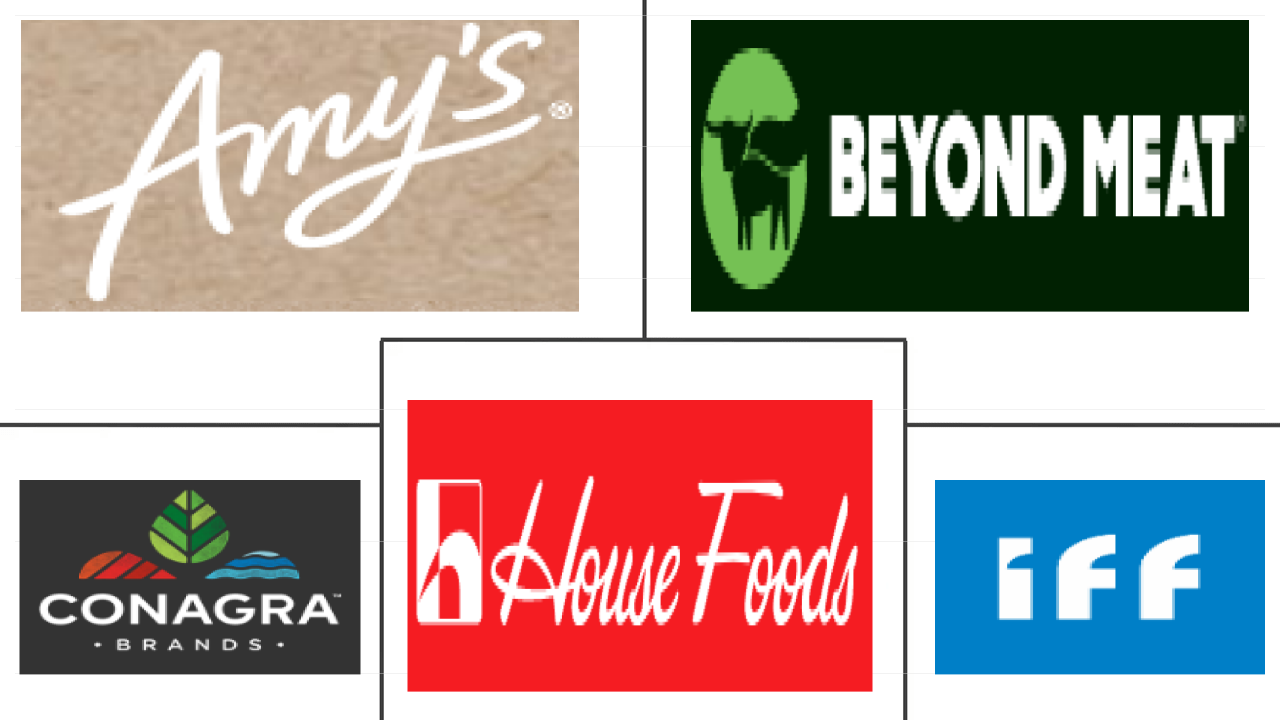Market Size of europe meat substitutes Industry
|
|
Study Period | 2017 - 2029 |
|
|
Market Size (2024) | USD 3.24 Billion |
|
|
Market Size (2029) | USD 5.42 Billion |
|
|
Largest Share by Type | Textured Vegetable Protein |
|
|
CAGR (2024 - 2029) | 10.86 % |
|
|
Largest Share by Country | United Kingdom |
Major Players |
||

|
||
|
*Disclaimer: Major Players sorted in no particular order |
Europe Meat Substitutes Market Analysis
The Europe Meat Substitutes Market size is estimated at 3.24 billion USD in 2024, and is expected to reach 5.42 billion USD by 2029, growing at a CAGR of 10.86% during the forecast period (2024-2029).
3.24 Billion
Market Size in 2024 (USD)
5.42 Billion
Market Size in 2029 (USD)
6.86 %
CAGR (2017-2023)
10.86 %
CAGR (2024-2029)
Largest Segment by Type
56.50 %
value share, Textured Vegetable Protein, 2023
Due to its close resemblance to the flavor and texture of meat and its versatility as an ingredient, it is preferred by the growing flexitarian population in the region.
Largest Segment by Country
19.45 %
value share, United Kingdom, 2023
The main driver for the meat substitutes market in the country is the popularity of veganism and campaigns encouraging plant-based diets and environment-friendly choices.
Fastest-growing Segment by Type
11.60 %
Projected CAGR, Tempeh, 2024-2029
The increasing need for different protein sources led to demand for tempeh with nearly 70% of the production volume occurring in Spain and France.
Fastest-growing Segment by Country
11.17 %
Projected CAGR, United Kingdom, 2024-2029
The growing demand for protein-rich meals having high fiber is driving the growth of meat substitutes in the United Kingdom, with TVP contributing 57% of the total sales.
Leading Market Player
7.99 %
market share, International Flavors & Fragrances Inc., 2022

The company has a wide production and distribution base in the region. They collaborate with various other players in the region to strengthen their position.
Emerging trends in the consumption of meat substitutes among flexitarians in Europe are driving the market
- Approximately 19% of flexitarians in European countries consumed tofu, tempeh, or seitan on a weekly basis, typically ranging from one to three times per week, in 2021. Around 10% of consumers in Europe consume tofu more than four times a week. The rising awareness of the health benefits associated with tofu consumption has also contributed to its increasing demand. Tofu is low in saturated fat, is cholesterol-free, and is a good source of essential nutrients like calcium and iron. It is often considered a healthier alternative to meat-based protein. The tofu segment is anticipated to register a CAGR of 10.97% by value during the forecast period.
- Based on type, textured vegetable protein (TVP) is the most widely consumed meat alternative. It accounted for a segmental volume of 16% in 2022. Its extensive application in producing different types of meat alternatives drives its sales. Regional manufacturers like Cargill, Ingredion, and ADM are augmenting the production of textured soy protein or pea protein for the meat alternatives industry. These companies are projected to support the growth of the European meat substitutes market further. The demand for pea-based TVP is growing rapidly, which is driving market players to create more non-soy-based, gluten-free meat alternatives.
- Tempeh is projected to record the fastest CAGR of 11.17% in terms of value during the forecast period. Manufacturers have introduced several tempeh products, such as organic tempeh, curry tempeh pieces, Mediterranean tempeh pieces, BBQ tempeh pieces, and smoky tempeh rashers, which is anticipated to boost the growth in the region. Moreover, players in the region are partnering with retail players to market their tempeh products.
Rise in vegan and flexitarian population boosts market growth
- The growth trend of the consumption of meat substitutes in Europe was static till 2021. It is expected to gain momentum rapidly during the forecast period. In 2022, 18-21% of the total European population was flexitarian, consisting of people who consumed meat and fish less frequently compared to traditional omnivores. People are slowly moving toward the consumption of meat substitutes to fulfill their protein requirements. The flexitarian population is further expected to increase to around 29-33% due to factors like environmental safety and sustainable diets. The flexitarian population has a significant impact on the meat substitute market as it is the largest dietary group after omnivores.
- The United Kingdom is the largest consumer of meat substitutes in the region and is expected to be the fastest-growing meat substitute market in Europe. It is projected to register a CAGR of 10.92% in value during the forecast period. There is an increasing availability of meat substitutes in supermarkets and country pubs, which is aiding the growth of the meat substitute market. Gen Z accounted for around 14-16% of the total population of the United Kingdom in 2022. The Gen Z population in the country is eager to try out the latest trends, such as the consumption of plant-based food and veganism, promoting the growth of the European meat substitute market during the forecast period.
- The Rest of Europe consumes meat substitutes primarily due to the shift to a more plant-based diet for better health and for the sake of the environment. Many consumers in countries like Sweden consume only vegetarian food, including meat substitutes, for about two to six times a week.
Europe Meat Substitutes Industry Segmentation Europe Meat Substitutes Industry Segmentation
Tempeh, Textured Vegetable Protein, Tofu are covered as segments by Type. Off-Trade, On-Trade are covered as segments by Distribution Channel. France, Germany, Italy, Netherlands, Russia, Spain, United Kingdom are covered as segments by Country.
- Approximately 19% of flexitarians in European countries consumed tofu, tempeh, or seitan on a weekly basis, typically ranging from one to three times per week, in 2021. Around 10% of consumers in Europe consume tofu more than four times a week. The rising awareness of the health benefits associated with tofu consumption has also contributed to its increasing demand. Tofu is low in saturated fat, is cholesterol-free, and is a good source of essential nutrients like calcium and iron. It is often considered a healthier alternative to meat-based protein. The tofu segment is anticipated to register a CAGR of 10.97% by value during the forecast period.
- Based on type, textured vegetable protein (TVP) is the most widely consumed meat alternative. It accounted for a segmental volume of 16% in 2022. Its extensive application in producing different types of meat alternatives drives its sales. Regional manufacturers like Cargill, Ingredion, and ADM are augmenting the production of textured soy protein or pea protein for the meat alternatives industry. These companies are projected to support the growth of the European meat substitutes market further. The demand for pea-based TVP is growing rapidly, which is driving market players to create more non-soy-based, gluten-free meat alternatives.
- Tempeh is projected to record the fastest CAGR of 11.17% in terms of value during the forecast period. Manufacturers have introduced several tempeh products, such as organic tempeh, curry tempeh pieces, Mediterranean tempeh pieces, BBQ tempeh pieces, and smoky tempeh rashers, which is anticipated to boost the growth in the region. Moreover, players in the region are partnering with retail players to market their tempeh products.
| Type | |
| Tempeh | |
| Textured Vegetable Protein | |
| Tofu | |
| Other Meat Substitutes |
| Distribution Channel | ||||||
| ||||||
| On-Trade |
| Country | |
| France | |
| Germany | |
| Italy | |
| Netherlands | |
| Russia | |
| Spain | |
| United Kingdom | |
| Rest of Europe |
Europe Meat Substitutes Market Size Summary
The Europe Meat Substitutes Market is experiencing significant growth, driven by a shift in consumer preferences towards plant-based diets. This trend is largely influenced by the increasing flexitarian population, who are reducing their meat consumption for health and environmental reasons. The market is characterized by a diverse range of products, with textured vegetable protein (TVP) being the most popular meat alternative. Companies like Cargill, Ingredion, and ADM are enhancing the production of soy and pea proteins to meet the rising demand for non-soy-based, gluten-free alternatives. Tofu and tempeh are also gaining traction, with tofu being favored for its health benefits and tempeh experiencing rapid growth due to innovative product offerings and strategic partnerships in the region.
The United Kingdom stands out as the largest and fastest-growing market for meat substitutes in Europe, supported by the increasing availability of these products in retail outlets and a youthful population eager to embrace plant-based trends. Other European countries are also witnessing a shift towards plant-based diets, with consumers in nations like Sweden adopting vegetarian lifestyles. Despite the rising demand, price remains a significant concern, with consumers perceiving plant-based foods as expensive. The market is fragmented, with major players like Amy's Kitchen Inc., Beyond Meat Inc., and Conagra Brands Inc. holding a modest share. Recent acquisitions and product expansions by these companies indicate a strategic focus on enhancing their presence in the European market, particularly in the tofu segment.
Europe Meat Substitutes Market Size - Table of Contents
-
1. MARKET SEGMENTATION (includes market size in Value in USD, Forecasts up to 2029 and analysis of growth prospects)
-
1.1 Type
-
1.1.1 Tempeh
-
1.1.2 Textured Vegetable Protein
-
1.1.3 Tofu
-
1.1.4 Other Meat Substitutes
-
-
1.2 Distribution Channel
-
1.2.1 Off-Trade
-
1.2.1.1 Convenience Stores
-
1.2.1.2 Online Channel
-
1.2.1.3 Supermarkets and Hypermarkets
-
1.2.1.4 Others
-
-
1.2.2 On-Trade
-
-
1.3 Country
-
1.3.1 France
-
1.3.2 Germany
-
1.3.3 Italy
-
1.3.4 Netherlands
-
1.3.5 Russia
-
1.3.6 Spain
-
1.3.7 United Kingdom
-
1.3.8 Rest of Europe
-
-
Europe Meat Substitutes Market Size FAQs
How big is the Europe Meat Substitutes Market?
The Europe Meat Substitutes Market size is expected to reach USD 3.24 billion in 2024 and grow at a CAGR of 10.86% to reach USD 5.42 billion by 2029.
What is the current Europe Meat Substitutes Market size?
In 2024, the Europe Meat Substitutes Market size is expected to reach USD 3.24 billion.

